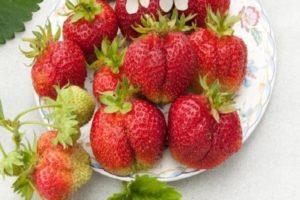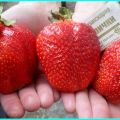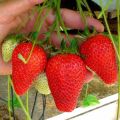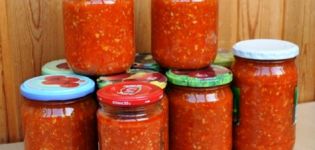Description and characteristics of the Khoney strawberry variety, planting and care
The developed variety is named after the city of Honeoye. Obtained by crossing the varieties Weibrant and Holiday. Growing strawberries Honey requires adherence to simple but important planting and care rules.
Description of the variety and its characteristics
Varietal indicators of a plant are what gardeners first of all pay attention to when deciding to breed a particular variety of strawberries. The taste indicators of berries, plant resistance to diseases, yield from a bush are taken into account.
The appearance of bushes and fruits
The bush is compact, powerful, with a well-developed root system, up to 0.3 m high. Leaves grow up to 22 cm long. The bush grows actively from the second week of April. Strawberry flower stalks are strong, capable of withstanding large berries. Fruit weight reaches 40 g. They are rich, bright red color, medium density. The berries are sweet with a pleasant sourness, have a rich strawberry aroma. At the end of the season, the berries become smaller, but the taste and aroma become richer.
When it blooms
In mid-May, the strawberry beds are covered with many white flowers. When flowering for two weeks, 14-16 flowers are formed on the bush.
When it gives a harvest
The berries ripen, depending on the place of growth, from mid-May to early June. When using growth stimulants, creating a greenhouse effect, strawberries will begin to bear fruit a couple of weeks earlier. The collection is carried out every 2-3 days. By the end of the season, there are fewer fruits, but strawberries are more aromatic and sweet.
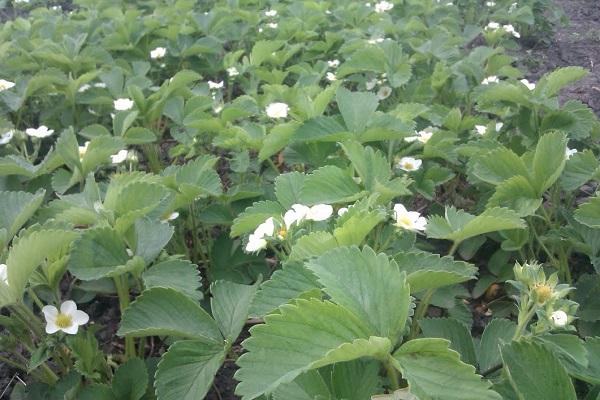
Resistant to weather conditions
Strawberries are unpretentious to external conditions. It tolerates heat well, can do without watering for 3-4 days. Perfectly tolerates low temperatures down to -18 aboutFROM.
The beginning of fruiting
This strawberry is considered a short day crop. Early grade. Under the film it ripens in late April - early May. In the southern regions, on open ridges, the first berries ripen in early May.
Storage times and transportability
Transportability is one of the advantages of the variety. The fruits retain their presentation for about 3 days. They tolerate transportation well.
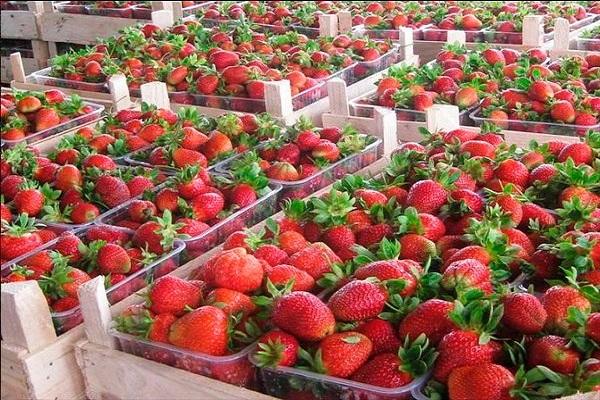
Using
In addition to using fresh berries, they are excellent for thermal processing, freezing. After thawing, the strawberries retain their pleasant aroma. Jams from it have aroma and pleasant sourness.
Growing regions
It grows well in the non-chernozem middle regions of Russia, in the center and in the south of Ukraine, Belarus. Since shrubs are sensitive to long periods of lack of moisture, it is best not to grow in dry areas.
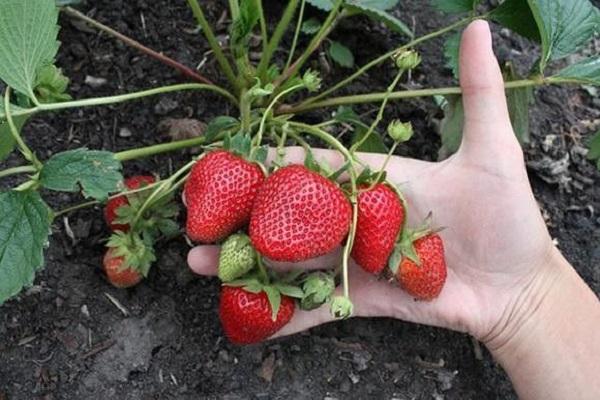
Advantages and disadvantages
The variety has the following positive aspects:
- yield, subject to agricultural technology, is 1.2 kg per bush;
- bears fruit steadily for several years;
- hardy, can survive even with inadequate care;
- tolerates hot weather, drought, waterlogging well;
- has an average, high immunity to some diseases;
- tolerates a decrease in temperature to -18 aboutFROM;
- the presentation is maintained for 3 days.
The disadvantages of this variety are minor:
- despite good immunity, strawberries are prone to damage by diseases of the root system;
- requires the correct water regime, with waterlogging, decay occurs;
- when stored for more than 3 days, the berries darken, become not juicy.
How to properly grow Honey Strawberries
To obtain a high-quality harvest, it is important to carefully consider the requirements for the choice of planting material and observe the technology of planting bushes.
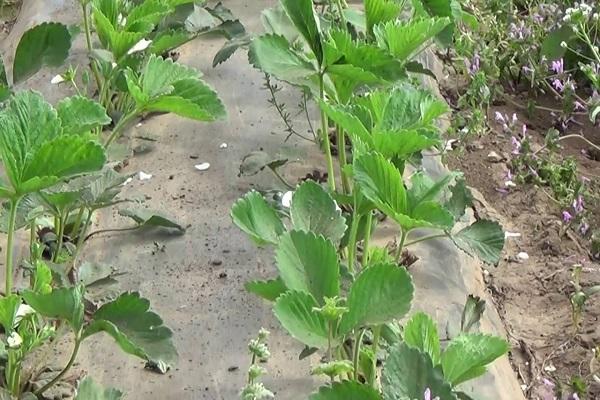
Requirements for planting material
It is recommended to purchase seed material in special stores or prepare it yourself. When using a whisker or dividing a bush, the mother plant must be healthy, not damaged.
Site selection and soil preparation
For full growth and fruiting, the bushes are recommended to be planted on flat areas. To prevent the development of fungal diseases, the area must be well ventilated. The place should be well lit and protected from the north wind. The soil is slightly acidic, sandy loam or loamy. A few weeks before planting the bushes, the soil must be fertilized with superphosphate, potassium sulfate and organic matter.
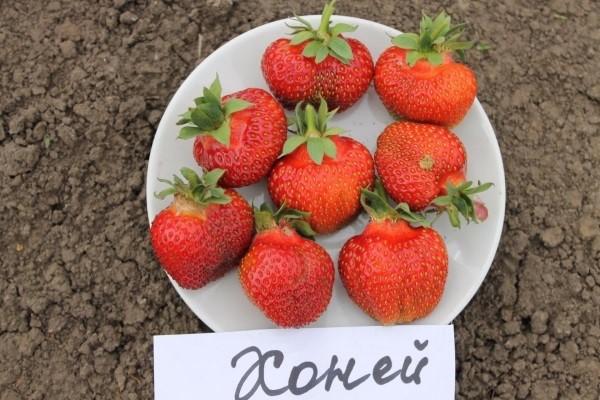
Planting garden strawberries
Sequence of actions for landing:
- rows are located at a distance of 0.5 m;
- it is recommended to land in cloudy weather or in the evening;
- the depth of the holes must be about 0.3 m;
- pour water into the hole, put bushes, sprinkle with earth;
- the apical bud should be at soil level;
- moisten the ground, carry out mulching.
The nuances of care
To obtain a high-quality, stable harvest, it is important to comply with simple, but necessary requirements for caring for strawberries.
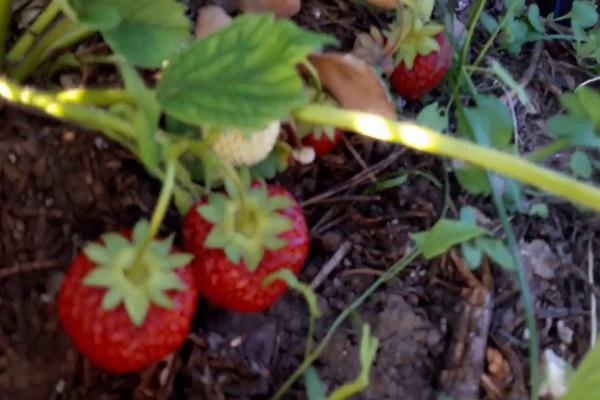
Watering
During the first week after planting the bushes, watering is done daily. Further, once a week is enough. In very hot weather - twice a week. Drip irrigation gives excellent results and helps save energy. Mulching is recommended to retain moisture.
Top dressing
This variety is unpretentious, but requires fertilization. In April, it is necessary to add a solution of mullein with urea in parts 1 to 10. When flowering, it is recommended to make foliar dressing. During the formation of ovaries, fertilize with mineral complex preparations. Make the last dressing after harvest. For this, organic fertilizers are used.
Mulching
This procedure is performed to preserve moisture and prevent the development of diseases. It also helps to keep the berries clean. Straw, dry grass, needles are ideal.
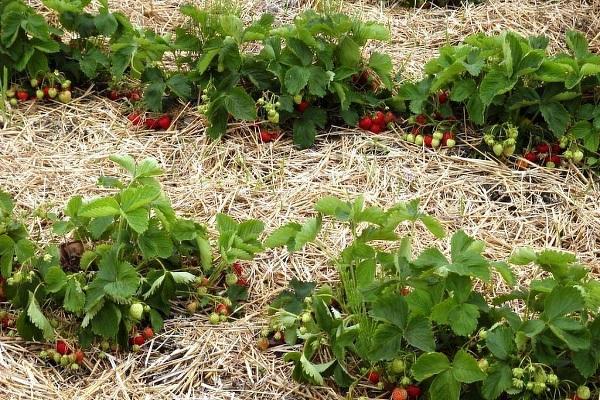
Preparing for winter
It is not recommended to weed strawberries in the fall, you can damage the roots, which will not have time to recover by winter. Remove dry, damaged leaves. After it is necessary to treat pests, diseases for prevention. In cold regions, as well as where there is little snow, it is recommended to provide shelter for the winter.To do this, use needles, straw or dry grass.
Breeding strawberries
In special-purpose stores, you can buy seeds and germinate them, then plant them in open ground. You can prepare the seeds yourself. To do this, you need to take a healthy strawberry, cut the skin thinly and dry it. Before germinating seeds, treat with a manganese solution, soak for a day and plant in a prepared container. Seedlings grow for 2-3 months. Transplant the bushes if there are 2-3 leaves.

But it is easier to buy or purchase strawberry seedlings in the nursery or from friends. If the strawberries grow on the site, it will not be difficult to propagate them. This variety gives a lot of mustache. To obtain high-quality seedlings, you need to leave 2-3 bushes for reproduction. All flower stalks must be cut off from such bushes. Leave only the antennae. They should take root over the season. At the end of summer, transplant them to a new place.
Reproduction can be done by dividing the bush. To do this, dig a bush over 3 years old. Place in a container of water to facilitate division. Divide the bush so that each part has a rosette. Trim the roots a few centimeters away. This will stimulate lateral root development. Treat the sections with a manganese solution. Plant in the beds.
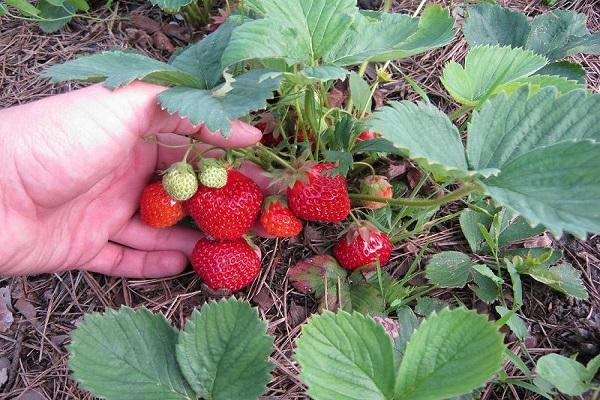
Diseases
The variety is susceptible to some types of fungal diseases. To prevent their spread, it is recommended to plant bushes in sufficiently ventilated areas, to carry out timely preventive treatment of plants.
Late blight wilting
Fungal infection, pathogens are considered microorganisms of the Phytophthora species. Bushes are infected through the affected rhizome. For treatment, it is recommended to treat with a solution of "Fundazol", which must be applied under the root of the bush. Produce high-quality drainage.
Gray rot
Bushes are infected by a fungus that spreads through the water and the atmosphere. The plant is completely affected. It is necessary to treat with a solution of Bordeaux liquid or means "Switch", "Derozal". To prevent the disease, experts advise changing the place of planting strawberries after 3-4 years.
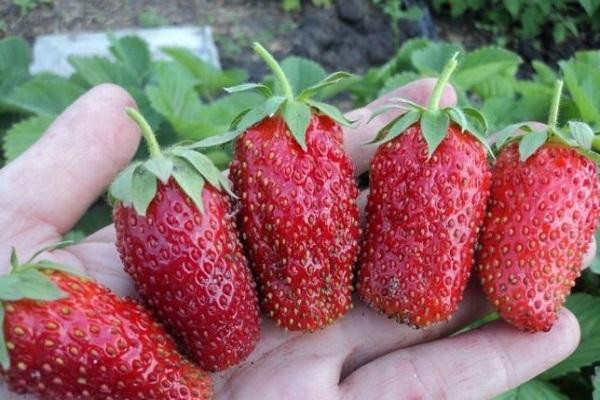
Brown spot
Caused by a fungus, infection occurs through the mycelium, which remains overwintering on the leaf plates. For destruction, you need to treat the plants with a solution of Bordeaux liquid before the start of the growing season.
Powdery mildew
Fungal infection that spreads through water or atmosphere. Rainy weather is an excellent breeding ground. Leaf plates and fruits are affected. To combat, it is recommended to treat the bushes with a copper emulsion with soap. Spray prior to flowering. After flowering it is recommended to use Topaz or similar preparations.
Pests
In addition to diseases, the bushes are overcome by pests, for the extermination of which it is recommended to use a number of measures. In addition, harmful insects can become carriers of diseases.
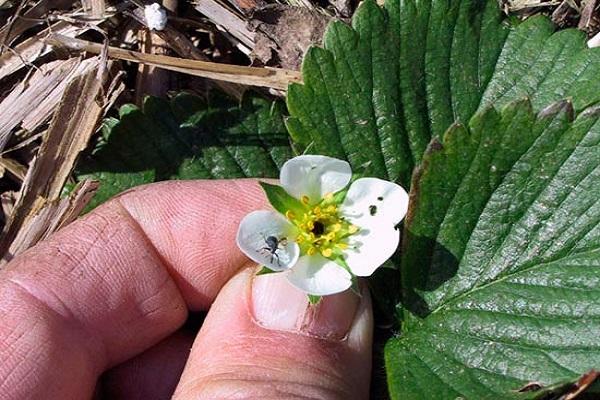
Strawberry whitefly
This very small insect looks like a white butterfly, 1.5 mm long. They settle from the bottom of the leaf plate, suck the juice out of it, and lay eggs on it. The larvae stick to the leaf plates of the bush and are not visible. They do not like sunlight, they hide in shaded areas. They overwinter in the upper layers of the soil and plant debris. For protection, treat bushes with pesticides before flowering and after harvest.
Beetle beetle
A bug, the size of which ranges from 3-4 mm, is brown in color. It actively destroys the pulp of the leaves during the entire growing season. Mainly activated during flowering bushes, ripening berries.
For prevention, it is necessary to weed out the cinquefoil and wild rosemary around the beds, since the beetle uses them for food. Loosening the soil destroys the pupa of the beetle, making it accessible to other insects.Before flowering, it is recommended to treat it with Karbofos or a similar insecticidal preparation. In early spring, pollinate the ridges with tobacco dust.
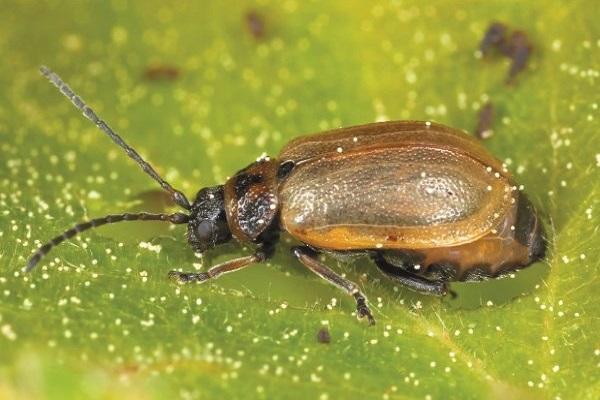
Nematode
These are transparent worms. They settle in plant tissues, feed on its juice. It is impossible to cure strawberries; the bushes must be removed with a root ball. Treat the earth with a solution of copper sulfate 5%.
Cleaning and storage
The first strawberries are harvested in mid or late May. Collection lasts 2 weeks, carried out every 2-3 days For transportation, an unripe berry with a whitish tip is collected. They are removed from the bush with a sepal and a fragment of the stalk, so they retain their presentation longer.
